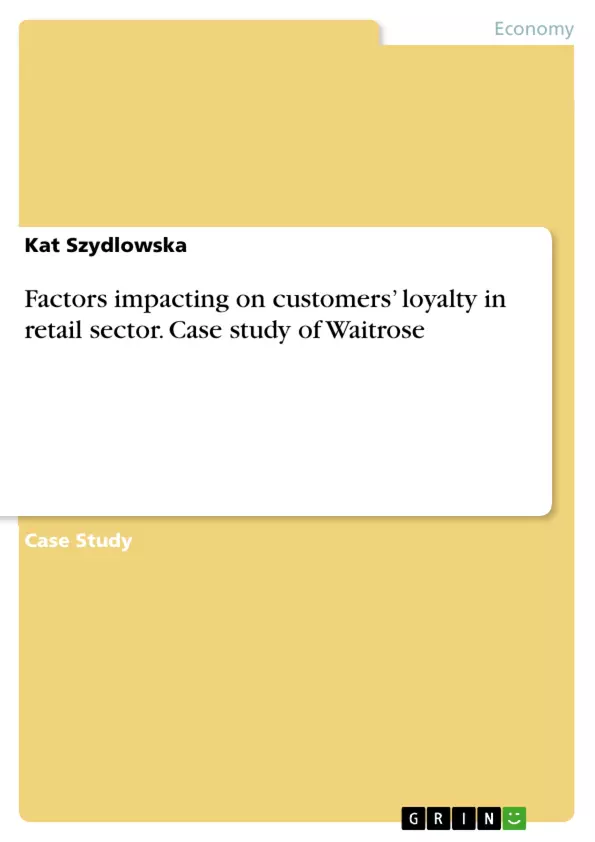The objectives of this study are:
1. To examine the impact of customer service on the customer loyalty in Waitrose store.
2. To analyse the role of corporate social responsibility in the selecting particular products
among the customers of Waitrose.
3. To investigate the influence of the loyalty programs on the customers loyalty in Waitrose.
Nowadays, when the competition is high and it’s difficult to get through to the market, it’s important to invest in relationship with customers. People, who are loyal to a particular brand, have high level of satisfaction, therefore world of mouth is important to gain more customers in the future.
Waitrose is one of the largest grocery retailers in the United Kingdom.
In 2011, the store introduced My Waitrose card- the type of loyalty scheme. This service enables customers to drink tea or coffee for free, discounts on specific products, free food magazine and access to other promotions in particular period. The store focus mainly on sales from quality, organic, free range products, what distinguishes it from other supermarkets. Within couple of years, Waitrose received many awards and acclaims e.g. Big Society Award and Best Loyalty Scheme.
Inhaltsverzeichnis (Table of Contents)
- Introduction
- Background of research
- Research questions
- Objectives of the study
- Literature review
- The definition of loyalty
- Factors impacting on customer's loyalty
- Customer service
- Loyalty programs
- Branding
- Corporate Social Responsibility
- Research methodology
- Research design
- Data collection
- Sampling
- Data analysis
- Time horizon
- Validity
- Reliability
- Ethical considerations
- Limitations of the study
- Conclusion
Zielsetzung und Themenschwerpunkte (Objectives and Key Themes)
This study aims to examine the factors influencing customer loyalty in the retail sector, specifically focusing on the case of Waitrose, a prominent grocery retailer in the United Kingdom. The research explores the impact of customer service, loyalty programs, and corporate social responsibility on customer loyalty. The study investigates how these factors contribute to customer satisfaction and retention within Waitrose.
- The significance of customer loyalty in a competitive market
- The impact of customer service on customer loyalty
- The role of loyalty programs in driving customer retention
- The influence of corporate social responsibility on customer purchasing decisions
- The importance of building strong customer relationships and fostering a sense of belonging
Zusammenfassung der Kapitel (Chapter Summaries)
- Introduction: This chapter introduces the research topic of customer loyalty in the retail sector and provides context for the study. It highlights the importance of customer loyalty in today's competitive market and discusses the key factors that contribute to customer retention. The chapter also introduces Waitrose as the case study for the research, highlighting its business model, loyalty program, and commitment to quality.
- Literature review: This chapter delves into the theoretical underpinnings of customer loyalty, exploring various definitions and perspectives. It discusses the attitudinal and behavioral aspects of loyalty, highlighting the importance of both customer satisfaction and repeated purchasing behavior. The chapter further examines the key factors impacting customer loyalty, such as customer service, loyalty programs, branding, and corporate social responsibility.
- Research methodology: This chapter outlines the research design and methodology employed in the study. It describes the data collection methods, sampling procedures, and data analysis techniques used to investigate the research questions. The chapter also discusses the ethical considerations and limitations of the research.
Schlüsselwörter (Keywords)
Customer loyalty, retail sector, grocery retail, Waitrose, customer service, loyalty programs, corporate social responsibility, brand reputation, customer satisfaction, retention, competitive advantage, relationship marketing.
- Arbeit zitieren
- Kat Szydlowska (Autor:in), 2017, Factors impacting on customers’ loyalty in retail sector. Case study of Waitrose, München, GRIN Verlag, https://www.grin.com/document/421553



